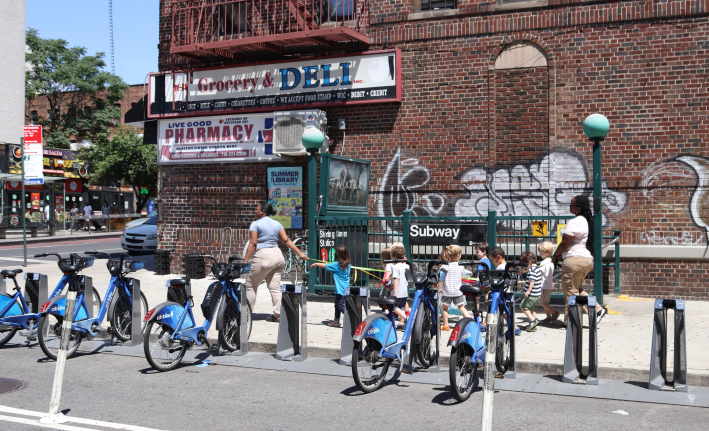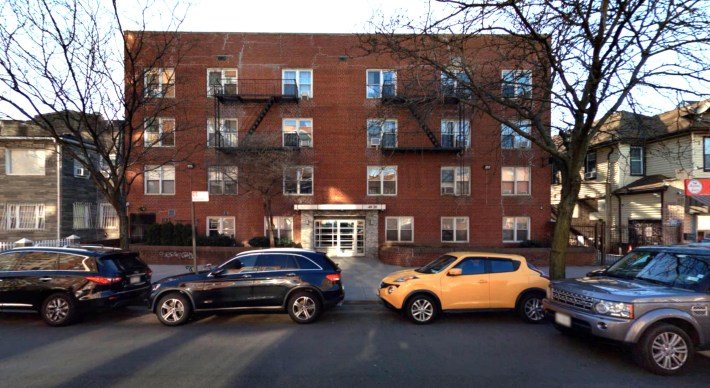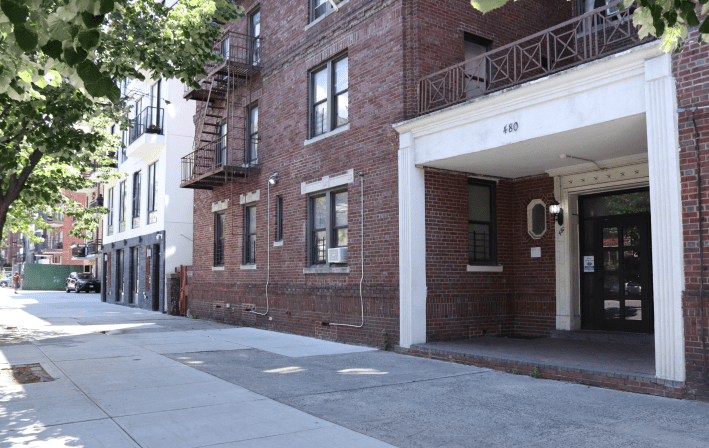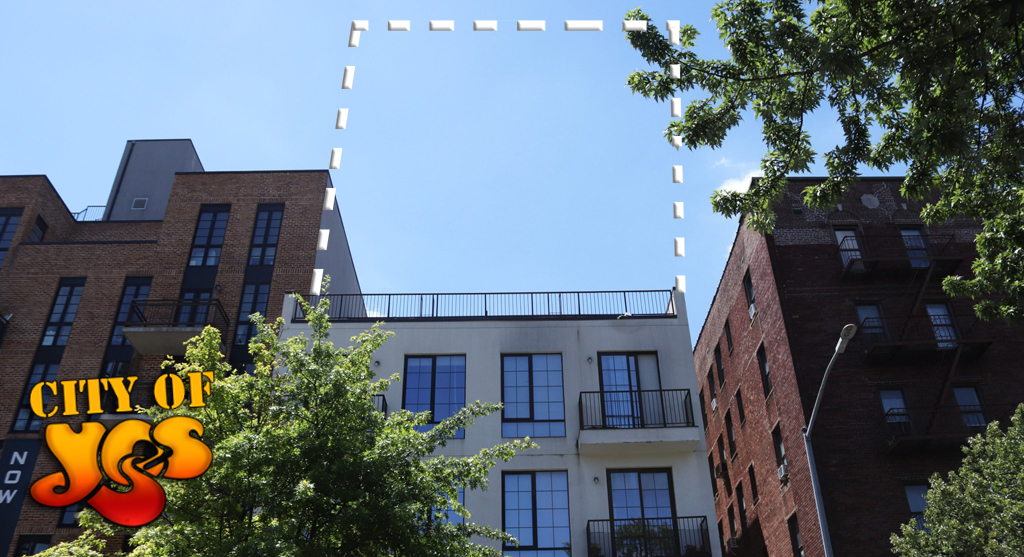On a single residential block in Brooklyn, three buildings illustrate why the Adams administration hopes to eliminate costly parking mandates as a part of its City of Yes housing plan.
The buildings are on Lefferts Avenue between Kingston and Brooklyn avenues. All three are less than half a mile from the 2 and 5 trains at Sterling Street:
- The six-story building at 480 Lefferts Ave. was constructed in 1939, before the city required builders to include parking. It has 48 residential units.
- At 492 Lefferts Ave., the developer built out to the maximum allowable under the zoning law in 2016, and, as such, had to include a costly underground parking garage. As a result, that lot has only 39 units.
- At 486-488 Lefferts Ave., the development company did not want to trigger the parking minimums, so it "under-built" — in other words, built fewer units than the zoning allowed. The resulting two buildings, completed in 2018, comprise just 18 units total — or 62 percent fewer units than the neighboring building at 480 Lefferts.
The City of Yes plan would change the city's zoning text to incentivize developers to build more units by getting rid of costly required parking minimums. That simple change — which doesn't eliminate parking, of course, but only the requirement — has been a controversial sticking point in the plan's ongoing public review process.
“You have to take a look at parking requirements if you do any type of zoning reform,” said Moses Gates, the vice president for Housing and Neighborhood Planning at Regional Plan Association. “It’s an integral part of a comprehensive strategy, something you can’t ignore.”

The city is in a housing crisis, a shortage of vacant apartments has led market-rate rents to increase by 36 percent since 2015, according to a Regional Plan Association report, City of Yes and Missing Middle Housing. Parking endures as a non-negotiable for housing development despite the fact that over 70 percent of New York City residents use public transportation to get to work, walk, or work from home, according to the 2022 American Community Survey.
Parking mandates — how did we get here?
Throughout the city there are examples of what experts call “middle-density” buildings that were constructed before parking mandates existed. These buildings make up characteristic New York neighborhoods, think five and six-floor walk-ups in Manhattan and rowhouses in the boroughs.
“Most of New York was built before 1961. You walk down a typical block, for instance a block of townhouses, there's no private parking,” said Gates.
Parking mandates are a product of the Robert Moses-era City Planning Commission, which introduced mandates in 1950 and expanded them in the '60s to include commercial and mixed-use buildings. The 1961 Zoning Resolution prioritized cars. Planners were trying to make the city feel more spread out and the vision was to organize and compartmentalize. Roads were built to connect new public parks to residential areas and parking mandates were a crucial component.
“The futuristic vision of New York at the time was ‘towers in the park’ connected by cars, it’s embodied in the 1961 zoning,” Howard Slatkin, the executive director of the Citizens Housing and Planning Council and a former top official at the Department of City Planning, told Streetsblog.
The parking mandates have done a lot to shape post-1961 New York due to the cost of building parking and the varying levels of feasibility depending on the size of the lot and the conditions of the area. As a result, New York has always had some exemptions for smaller lots, which has incentivized under-building.
“The requirement to provide parking sets up an incentive to build smaller buildings because as soon as you go past a certain threshold you need to provide parking, and that’s not a trivial expense,” said Slatkin.
Under-building
The average cost of building an underground parking space in the city is $67,500, according to the planning department. The city is filled with examples of developers under-building in order not to have to build costly parking.
"The developer is very math driven, they’re going to make rational economic decisions. They won't encumber themselves with additional regulation if they don’t have to," said Tucker Reed, the co-founder of Totem, a development company based in Brooklyn, and former head of the Downtown Brooklyn Partnership.
On Lefferts Avenue, 488 and 486 are unique because the lots are bigger than the standard that usually have four-story, nine-unit buildings. The developer could've used the extra lot space to justify building more units, but didn’t.
Four-story-plus-penthouse buildings are so common in R6 districts like Wingate because they strike the balance of maximizing floor-area ratio (how zoning code determines how many units are allowed on a certain lot size) while staying under the 10-unit threshold that triggers the parking requirement. However, on wide streets like Lefferts Avenue, the builders of 488 and 486 could have built bigger, but they didn't because it would trigger a requirement to build at least five parking spaces.
“Maybe as a builder I might be willing to provide a few spots, but to provide this number that's handed down from this pseudoscience of parking requirements can have all of these catastrophic costs for the building,” said Slatkin.
Roughly 94 percent of units in the district are occupied, this scarcity of housing drives up rents — and under-building contributes to the scarcity.
The missing middle
Bloomberg-era contextual zoning from 2002 to 2013 coupled with enduring mandated parking minimums has also contributed to under-building.
Take the R5D zoning district as an example. This contextual zoning district was designed to “encourage residential growth along major corridors in auto-dependent areas of the city,” according to the city. These districts are mapped in places like Woodside and Sunnyside in Queens and on Williamsbridge Road in the northeast Bronx. In order to build in this district a developer must provide parking at an 85-percent ratio to the amount of units built. Experts say this is not feasible for these size lots and results in lost housing.
“You can build apartment buildings in theory, but they rarely get built because providing all that parking is extremely difficult and uneconomical,” said Slatkin. “In R5 districts, you will see fewer units than are permitted on those sites because the parking requirements are so high.”

Zoning districts R1-R4 — which are common in many Queens neighborhoods as well as those with a lot of detached homes — require one parking spot to be provided for every unit of housing built. R5 is the lowest-density zoning district that doesn't require 100 percent of units to have a parking space, but 85 percent of units must still get parking, so it is almost impossible for developers to go beyond single family buildings.
A report from Citizens Housing & Planning Council estimated that from 2011 to 2020, R1-R5 districts produced 0.45 new housing units per 1,000 residents per year, behind even the suburbs in Long Island.
The Regional Plan Association report shows that the zoning amendments introduced between 2002 and 2013 affected 46 percent of the city's lots. These zoning amendments adopted strict rules which severely limited development of middle-density housing, like the ones built before parking mandates.

One of the main goals of City of Yes is to re-introduce the "missing middle" housing to R1-R5 districts by allowing bigger buildings near transit, mixed use town-center zoning, accessory dwelling units, and getting rid of parking mandates.
"Together, they represent a holistic and interconnected strategy to expand housing stock more equitably in every neighborhood," says the Regional Plan Association report.
Parking reforms are successful
Since the Moses era, there have been some parking-related zoning reforms that prove the effectiveness of removing mandates. In the 1980s, mandates were lifted in the Manhattan core to help the city better comply with the Clean Air Act, in 2011 mandates were lifted in some parts of Long Island City, in 2012 a Downtown Brooklyn rezoning cut required minimums in half, and in 2016 the city’s zoning code was amended to waive mandates for affordable and senior housing within transit zones – or lots within one-half mile of a subway entrance. Before these exemptions, less affordable housing was built because developers wouldn’t be able to make up the cost of building parking garages.
“Because the parking is a deadweight loss of the building’s finances, at a certain point the deal breaks down and then [the affordable units] don’t get built,” said Slatkin.
In cases where parking mandates are no longer required, development has increased, showing the potential for more housing if mandates are removed citywide.
“Now [developers] can take a holistic approach to the design of the building and not base it on arbitrary standards that don't match the needs of the population they are trying to serve,” Slatkin said.
A 2022 report from the Regional Plan Association found that removing parking mandates for affordable housing resulted in 36-percent more affordable units annually in the transit zone between 2016 and 2020.
Another way that developers are already getting around parking mandates in higher density districts is by obtaining a special permit through a Uniform Land Use Review Procedure. The permit was created in 2016, since then, there have been 19 projects that have sought one, usually as a part of other rezoning actions.

A new building of luxury condos in Clinton Hill, 108 Downing St., was built in 2022. The developer started the nearly 12-step process of obtaining the special permit in 2019. The luxury condo building will be able to make up the costs of going through the special permit process, but a developer seeking to build more affordable units might not. The expensive and long process makes it difficult to build any housing without parking, even in neighborhoods where the zoning allows for bigger projects.
“Parking requirements not only restrict housing that’s needed, but restrict the ability to build housing even that’s allowed,” said Gates.
According to the planning department, the 19 projects, which are in varying stages of development, will provide upwards of 5,700 new homes, at least 1,140 of which will be affordable.
If they are all approved ...
Community backlash
The City of Yes for Housing Opportunity is unique because it breaks the pattern of contextual zoning changes and instead proposes small changes to every district and removes parking mandates everywhere.
"Rather than relying on massive one-off rezonings to put a dent in [the housing shortage], which won't ever actually work in a comprehensive way, asking every neighborhood to shoulder a little bit more density to have collective massive impact is a breath of fresh air,” said Reed.
The public review process began in May and community boards have until the first week of July to send their recommendations. Streetsblog has monitored the first phase of that review — community board meetings across the city — and has observed predictable fighting over parking mandates and changing neighborhood characteristics with new buildings.
But Reed, who worked on the Downtown Brooklyn Parking Text Amendment in 2012 as head of the Downtown Brooklyn Partnership, says that once mandates are removed or reduced residents won't even notice it.
"At the end of the day, nobody even notices if these minimums get eliminated because we live in a city with the greatest transit system in the world," Reed told Streetsblog.
Some community boards have shown support. Queens Community Board 2, which includes the R5D district example and many low- to mid-density zoned blocks, approved the plan 38-5, according to the Queens Chronicle.
And in Brooklyn, CB7 which includes Sunset Park and CB6 which includes Park Slope approved the plan. The two community districts both include mostly R6 and R5 zoning blocks. CB7 offered recommendations to adjust the plan to push for more affordable housing, and some members of the public didn't want to get rid of the parking mandate because they fear other drivers will swipe "their" free street parking. Meanwhile, CB6 accepted the proposal as-is.
In Brooklyn, Community Board 9, which includes the block on Lefferts Avenue, rejected City of Yes, claiming it would lead to displacement.

“We’re looking to preserve the neighborhood character,” Chairman Fred Baptiste said at the June 24 meeting.
“What this is really doing is putting in the hands of developers rather than community boards and council members to negotiate where things like parking waivers are appropriate,” added the board's ULURP Committee Chair Suwen "Suki" Cheong. “It will essentially just allow everything, everywhere, whenever the developers see it as most profitable.”
But housing experts see vacancy rates as the main driver of displacement.
"The vacancy rate really is a factor in tearing families and communities apart because if someone has to move, they might not be able to find housing where they can be close to the people and things they want to be close to," Slatkin told Streetsblog. "There are things that are complicated about growth, but the absence of growth means housing for fewer people and more displacement, period."






